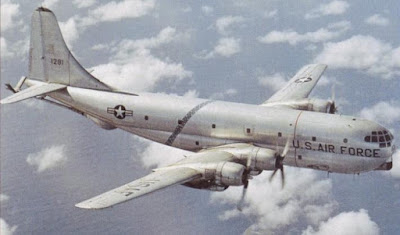The Boeing C-97 Stratofreighter was an American, long-range, transport aircraft in service with the US Air Force during the Cold War period. It was based on the B-29 Superfortress bomber, which had been used during World War II. Thus, using the wings and lower portion of the bomber's fuselage, Boeing developed the first large, long-range cargo plane. Also a tanker version would be produced, the KC-97. During the Korean War, it was used as a casualty evacuation aircraft.
The prototype XC-97 (Model 367) was first flown on November 9, 1944. During flight tests, it was able to fly from Seattle, on the west coast, to Washington DC, in 6 hours and 3 minutes, carrying 9,072 kg (20,000-lb) payload and cruising at 9,144 m (30,000 feet) of altitude. The aircraft would finally enter service with the US Air Force on July 27, 1947, as the C-97A Stratofreighter. The KC-97G version was a tanker that was also capable of carrying freight or troops without removing the refueling system; this would become the most common model. Cargo was loaded onto the plane through a couple of rear gates in aft portion of fuselage, using a ramp.
Technical Characteristics
The Boeing C-97 Stratofreighter was a large, four-engine monoplane, with cantilever wing and all-metal fuselage. In order to produce this transport aircraft, the simplest structural route was followed. The lower fuselage lobe was of similar diameter to that of the B-29. Meanwhile, the upper fuselage, which had a circular cross-section was larger, with a greater diameter. Thus, the plane had two pressurized circular-section cabins in the fore portion of aircraft.
The C-97 was equipped with an AN/APS-42 search radar, which was housed in aircraft nose radome. Each of the Pratt & Whitney, 28-cylinder, radial engines provided 3,500 horsepower (2,610 kW), turning a four-blade propeller. Many KC-97G tankers would be fitted with two General Electric J47-GE-25 turbojets to give the aircraft more strength and longer range. The aircraft was fitted with tricycle landing gear, with the main wheels retracting into engine nacelles.
 |
| Above, the C-97A transport version about to touch down in 1954. |
Specifications
Type: long-range transport/tanker aircraft
Length: 33.63 m (110 feet, 4 inches)
Wing Span: 43 m (141 feet, 3 inches)
Wing Area: 164.34 m2 (1,769 square feet)
Height: 11.66 m (38 feet, 3 inches)
Power Plant: four 3,500-HP, Pratt & Whitney R-4360-59, 28-cylinder, radial piston engines.
Maximum Speed: 604 km/h (375 mph)
Range: 6,920 km (4,300 miles)
Service Ceiling: 9,205 m (30,200 feet)
Crew: 6
Capacity: 9,072 kg (20,000-lb) payload, or 125 well-equipped troops or 69 stretchers.
 |
| The C-97 Stratofreighter in flight over the Pacific. |
 |
| Above, the KC-97G version of the C-97. Notice the fuel boom sticking out backwards from belly of rear portion of fuselage. |